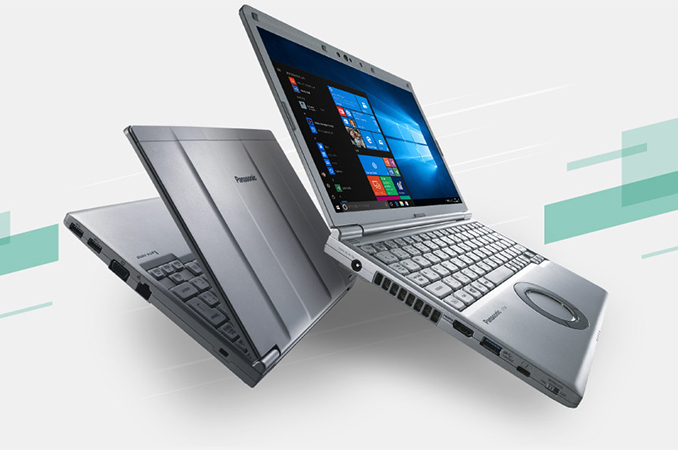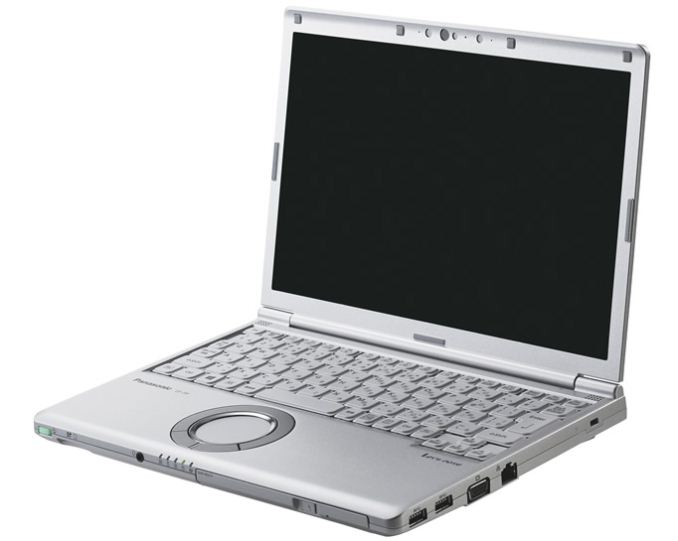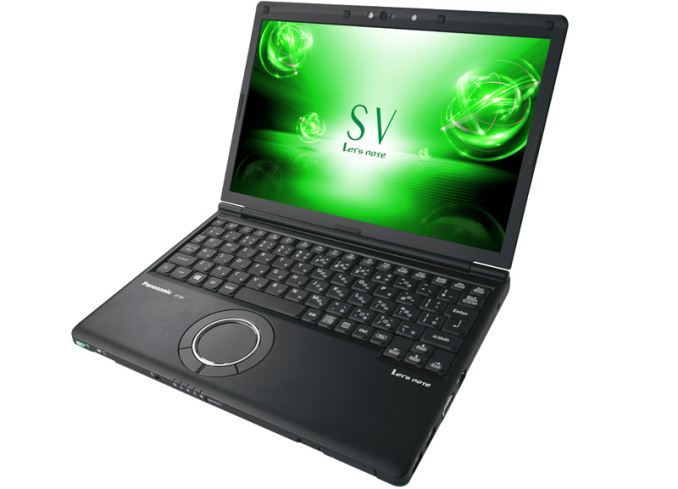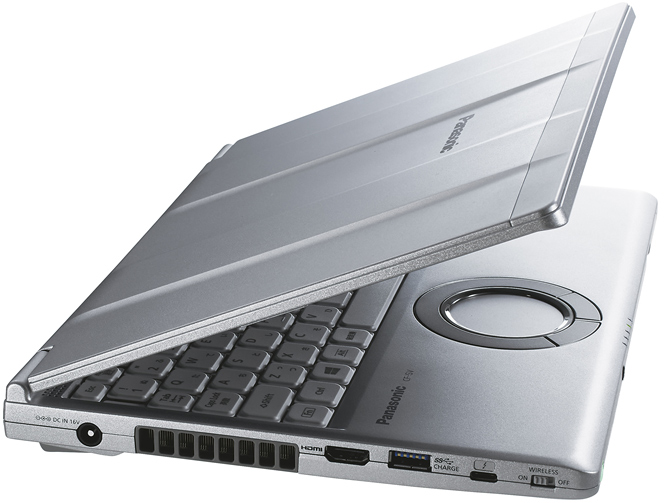Panasonic Unveils Let’s Note SV7: 12.1-Inch, Quad-Core CPU, TB3, ODD, 21 Hrs, 2.4 Lbs
by Anton Shilov on February 13, 2018 11:00 AM EST- Posted in
- Notebooks
- Intel
- Panasonic
- Core 8th Gen
- Let's Note

Panasonic has upgraded its 12.1-inch series laptops with Intel’s quad-core 8th Generation Core i5/i7 CPUs. The new Panasonic Let’s Note CF-SV7-series notebooks are the only ultra-compact PCs to feature Intel’s latest mobile processors, a Thunderbolt 3 interconnection, an optical drive and an optional LTE modem in a package that weighs from 999 grams to 1.124 kilograms (2.2 – 2.47 pounds).
Panasonic is one of a few companies nowadays that offers highly-integrated ultra-compact laptops with optical disc drives. These machines are very light because they are made of plastic (they are still rugged enough and can be dropped from a height of 76 cm) and their weight is about a kilogram, but they are not ultra-thin like modern notebooks from Apple, HP or Lenovo. To a large degree, they are relatively thick because they are designed to offer their owners the best possible connectivity, feature set and battery life, something that we usually see on 14”/15.6” laptops from other manufacturers. In Europe and the U.S. many people nowadays prefer ultra-thin PCs even if they lack replaceable batteries or certain ports (and I am not even talking about laptops with ODDs — they have become exotic). User preferences are different in Japan, which is why Panasonic still offers 12”-class laptops with optical drives, thick replaceable batteries and plenty of connectors.
The Panasonic Let’s Note CF-SV7 family of notebooks succeeds the company’s Let’s Note CF-SZ6 lineup that featured a similar appearance, a 12.1” WUXGA (1920×1200) display, comparable weight and dimensions as well as a very long battery life of up to 21 hours (enabled by a removable accumulator). Meanwhile, even though the CF-SV7 continues traditions of the CF-SZ6, it does not mean that Panasonic just installed new quad-core CPUs into an old chassis.
The Let’s Note SV7-series based on Intel’s quad-core Core i5/i7 processors actually uses a new chassis that is 24.5 mm thick (down from 25.3 mm in case of the SZ6) and features a new cooling system for its new CPUs. Because of the new cooler, the SV7 PCs are a bit heavier than their predecessors, but even when equipped with a high-capacity “L” battery, their weight does not exceed 1.124 kilograms. Besides the new quad-core 8th Generation Core i5/i7 processors, Panasonic’s latest SV7-series laptops obtained a Thunderbolt 3 port, a rare feature for 12”-class mobile computers.
Exact configurations of Panasonic’s Let’s Note CF-SV7 vary greatly. Retail versions of the CF-SV7 are equipped with Intel’s Core i5-8250U or Core i7-8550 CPUs, 8 GB of LPDDR4-1866 memory and a SATA SSD (128 GB – 1 TB). Meanwhile, built-to-order models bought directly from Panasonic can be customized to feature Intel’s Core i5-8350U or Core i7-8650U, 16 GB RAM as well as a 1 TB PCIe SSD. As for connectivity, the systems are outfitted with an 802.11ac + Bluetooth 4.1 wireless module, a GbE connector, three USB 3.0 Type-A ports, a D-Sub output, an HDMI 2.0 header (supporting 4Kp60 resolution), a TRRS audio connector and so on. In addition, the systems feature stereo speakers, a microphone, a 720p webcam with an IR sensor compatible with Windows Hello, an SD card reader supporting SDHC/SDXC cards with UHS-II interface as well as a CD/DVD burner/reader or a Blu-ray reader/CD/DVD burner. Some systems come with a 4G/LTE modem, other can be configured to include a 1 TB HDD in addition to a 128 GB SSD. It is noteworthy that the width of a key on SV7’s keyboard is 19 mm, comparable to that of a modern MacBook Pro. Meanwhile, the new SV7 continues to feature Panasonic’s round touchpad that does not look too comfy.
Besides high integration, the Let’s Note CF-SV7-series can be proud of its battery life. When equipped with an “S” battery and an SSD, the laptop can work for up to 14 hours, according to Panasonic. Meanwhile, if an “L” accumulator is installed, the system is rated for 21 hours, probably a record for 12”-class PCs in general.
| General Specifications of Panasonic Let's Note CF-SV7-Series | |||||
| "High-End" | "Mainstream" | "Entry" | |||
| Display | 12.1" non-glossy 1920×1200 resolution |
||||
| SoC | Core i7-8550U Core i7-8650U* |
Core i5-8250U Core i5-8350U* |
|||
| RAM | 8 GB LPDDR3 16 GB LPDDR3* |
||||
| Storage | 256 - 512 GB SSD SATA up to 1 TB SSD PCIe* |
128 - 256 GB SSD SATA up to 1 TB SSD PCIe* |
1 TB HDD 128 GB SSD + 1 TB HD* up to 1 TB SSD PCIe* |
||
| ODD | CD/DVD burner BD reader/CD/DVD burner* No ODD* |
- | |||
| Camera | 720p webcam with IR sensor for Windows Hello | ||||
| Wireless | 802.11ac Wi-Fi Bluetooth 4.1 optional 4G/LTE modem 300/50 Mbps |
||||
| I/O ports | 3 × USB 3.0 Type-A 1 × Thunderbolt 3/USB Type-C 1 × HDMI 1 × D-Sub 1 × GbE SD card reader with UHS-II support |
||||
| Audio | Integrated speakers and microphone 1 × TRRS 3.5-mm jack for headset |
||||
| Dimensions | 283.5 × 203.8 × 24.5 mm | ||||
| Weight | 999 - 1124 grams | ||||
| Battery Life Based on JEITA 2.0 | Up to 21 hours with L battery and SSD Up to 14 hours with S battery and SSD Up to 11 hours with S battery and HDD |
||||
| OS | Windows 10 Pro | Windows 10 Home Windows 10 Pro |
Windows 10 Pro | ||
| Finish | Body: Silver or Black* Top Cover: Silver, Black*, Blue*, Dark Red* |
||||
| Notes | *Available only directly from Panasonic | ||||
As mentioned above, Panasonic’s Let’s Note CF-SV7 laptops will come in different configurations. A basic one featuring Intel’s Core i5-8350U, 8 GB of RAM, a 256 GB SSD, a DVD drive and an “S” battery pack costs ¥253,584 w/taxes (~$2320) when bought online. A premium one equipped with Intel’s Core i7-8650U, 16 GB of RAM, a 1 TB SSD, a Blu-ray drive, an LTE modem and an “S” battery is priced at ¥425,304 w/taxes (~$3880) when bought directly from Panasonic. The Let’s Note CF-SV7 PCs are definitely priced well above average, but the systems offer unique features that tend to cost a lot.
Related Reading:













25 Comments
View All Comments
ZeDestructor - Tuesday, February 13, 2018 - link
Add a metal chassis and a UHD 4K screen and you have my attention tooMamiyaOtaru - Wednesday, February 14, 2018 - link
So fugly. I love it! So sick of ultrabooks and making them thin at the expense of other stuff. Give me some additional thickness with better cooling, battery life and connectivity. And a smaller screen (12 or even less) is fine. ODD can go away though.This one bucks some trends I don't like and offers a lot that I do. TBH it just might be too ugly though
piroroadkill - Wednesday, February 14, 2018 - link
Huh, I like it. I really question the value of an optical drive in a laptop these days, I even swapped the one out in my Sony Vaio Z13 for another SSD, but otherwise, I like their old-school design principles. That 16:10 screen is great, the enormous cooling vents functional, but that tiny trackpad looks like it could be a bit irritating.seetohey - Wednesday, February 14, 2018 - link
Does anyone know if the TB3 port has 4 lanes?serendip - Thursday, February 15, 2018 - link
I was all "Yes! Yes!" until I saw the insane pricing. A chunky laptop priced at $3000 isn't just optimistic, it's plain crazy. There's no way these machines will sell anywhere outside Japan.That said, I hope other manufacturers take note of some good bits about these machines. A light and durable plastic body can take more punishment and weighs less than aluminum while being cheaper than carbon fiber. I'd ditch the optical drive in favor of a second HDD bay and hopefully a large 21-hour battery can fit into a thinner 1" high chassis.
Oh, and please stop using accumulator: it's like a 19th century term for a battery pack.